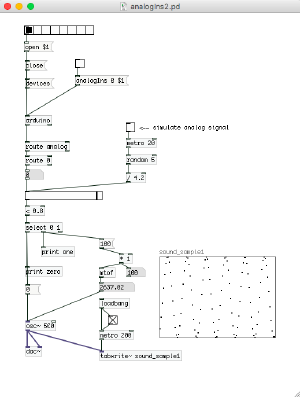No edit summary |
No edit summary |
||
| Line 1: | Line 1: | ||
[[File:Screen Shot 2017-10-08 at 11.50.32 AM.png|300px|thumb|left| | [[File:Screen Shot 2017-10-08 at 11.50.32 AM.png|300px|thumb|left|Pd sketch]] | ||
''Lecturer:'' [[GMU:Mindaugas Gapševičius|Mindaugas Gapševičius]]<br> | ''Lecturer:'' [[GMU:Mindaugas Gapševičius|Mindaugas Gapševičius]]<br> | ||
''Credits:'' 6 [[ECTS]], 2 [[SWS]]<br> | ''Credits:'' 6 [[ECTS]], 2 [[SWS]]<br> | ||
Revision as of 15:20, 10 October 2017
Lecturer: Mindaugas Gapševičius
Credits: 6 ECTS, 2 SWS
Date: Fr. and Sa., 08.-09.12.2017, 10:00-18:00
Venue: Marienstrasse 7b, Raum 204
First meeting: Thursday, 12th of October 13:30-16:45
This course is designed as a trigger to foster imagination and skills around human and non-human interaction. We will focus on a free, open source, and cross-platform Pure Data (Pd) visual programming language, which will become our tool and expression for building simple interactive applications. To bridge organisms and computers, we will use Arduino and DIY sensors. Participants with no skills in Arduino or electronics are encouraged to take the course on Arduino offered by Timm Burkhardt.
Students will be expected to develop small projects, which will be presented at Winterwerkschau and/or at the >top Schillerpalais project space in Berlin.
